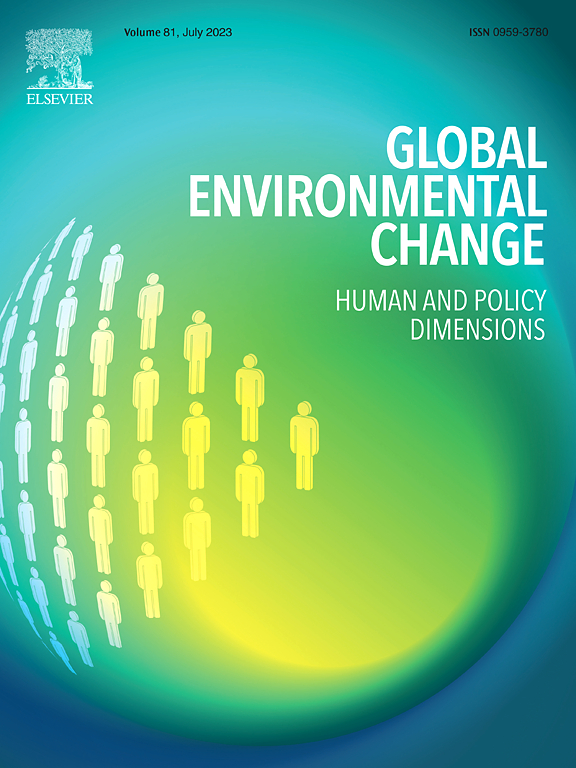日常生活条件下的热浪适应:分析太平洋西北夏季日常活动的相互作用变化
IF 9.1
1区 环境科学与生态学
Q1 ENVIRONMENTAL SCIENCES
引用次数: 0
摘要
随着热浪的强度、频率和持续时间的增加,迫切需要进行适应,以限制其对健康、福祉和生计的不利影响。热浪期间的热暴露和适应性反应与移动行为密切相关,这是一个快速增长的文献主体。然而,对形成和限制寻求降温机会的过程的了解仍然有限,因为学术研究尚未研究人们如何改变日常生活中的各种活动以应对热浪。为了解决这一差距,目前的论文同时模拟了这些相互依存的活动变化,揭示了热浪期间的行为适应以及影响它们的潜在结构。结合谷歌社区流动性报告、ERA5气候再分析和北美太平洋西北地区的社会经济数据,该分析使用多变量多层次模型来研究夏季热浪期间固定(家庭、工作、交通)、基本(杂货店/药房)和可自由选择(零售/娱乐、公园)活动如何共同变化。以气候多样性区域为重点,将热浪作为不同的多日事件进行建模,通过热浪的气候、时间和背景特征探索这些相互依赖的响应。结果表明:(1)典型气候对工作场所的刚性和对热浪期间非工作活动的适应有影响;(2)绝对强度和相对强度对行为反应的影响不同但也相当大;(3)适应随着时间的推移而演变,在热浪之间和内部都是如此;(4)城市形态和社会经济差异影响热浪期间的活动权衡。通过将热浪置于人们日常生活的背景下,本研究强调了适应发生的多样化、动态但受限的过程。本文章由计算机程序翻译,如有差异,请以英文原文为准。
Heatwave adaptation conditioned by everyday life: Analysing interacting changes to daily activities during Pacific Northwest summers
As heatwaves increase in intensity, frequency, and duration, there is an urgent need for adaptation to limit their adverse effects on health, well-being, and livelihoods. Heat exposure and adaptive responses during heatwaves are tightly linked to mobility behaviours – the subject of a rapidly growing body of literature. However, knowledge of the processes which shape and constrain opportunities to seek cooling remains limited, as academic research has yet to examine how people alter the various activities of everyday life in response to heatwaves. Addressing this gap, the current paper models these interdependent activity changes simultaneously, shedding light on behavioural adaptations during heatwaves and the underlying structures which condition them. Combining Google Community Mobility Reports, ERA5 climate re-analysis, and socio-economic data across the Pacific Northwest region of North America, the analysis uses a multi-variate multi-level model to examine how anchor (home, work, transit), essential (grocery/pharmacy), and discretionary (retail/recreation, parks) activity change together during summer heatwaves. Focusing on a climatically diverse region and modelling heatwaves as distinct multi-day events, these interdependent responses are explored with the climatic, temporal, and contextual features of heatwaves. Four main conclusions about behavioural adaptation to heatwaves are drawn: (1) A region’s typical climate impacts workplace rigidity and adaptations to non-work activities during heatwaves; (2) Absolute and relative intensities have distinct yet comparably large impacts on behavioural responses; (3) Adaptation evolves over time, both between and within heatwaves; (4) Urban form and socio-economic disparities influence activity trade-offs during heatwaves. By contextualizing heatwaves within people’s everyday lives, this study highlights the diverse, dynamic, and yet constrained processes by which adaptation occurs.
求助全文
通过发布文献求助,成功后即可免费获取论文全文。
去求助
来源期刊

Global Environmental Change
环境科学-环境科学
CiteScore
18.20
自引率
2.20%
发文量
146
审稿时长
12 months
期刊介绍:
Global Environmental Change is a prestigious international journal that publishes articles of high quality, both theoretically and empirically rigorous. The journal aims to contribute to the understanding of global environmental change from the perspectives of human and policy dimensions. Specifically, it considers global environmental change as the result of processes occurring at the local level, but with wide-ranging impacts on various spatial, temporal, and socio-political scales.
In terms of content, the journal seeks articles with a strong social science component. This includes research that examines the societal drivers and consequences of environmental change, as well as social and policy processes that aim to address these challenges. While the journal covers a broad range of topics, including biodiversity and ecosystem services, climate, coasts, food systems, land use and land cover, oceans, urban areas, and water resources, it also welcomes contributions that investigate the drivers, consequences, and management of other areas affected by environmental change.
Overall, Global Environmental Change encourages research that deepens our understanding of the complex interactions between human activities and the environment, with the goal of informing policy and decision-making.
 求助内容:
求助内容: 应助结果提醒方式:
应助结果提醒方式:


